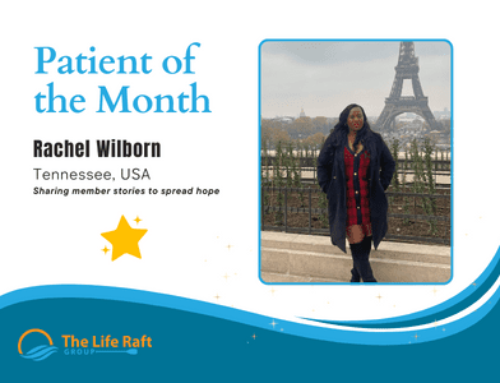I’ve been thinking a lot about writing this article. The last thing I want to do is cause worry or pain to anyone reading this. Then I thought of all the people who could possibly benefit in the future from knowing ahead of time what we didn’t know at the time we needed to know it. This is for anyone facing end of life issues, for any family member, with any illness, who can benefit from learning about hospice before the need arises. So here we are, talking about a delicate subject from the point of view of someone having recently lived it. If you ever had a pang of fear when hearing the word “hospice” I hope our story will dispel that fear.
 Our decision began when my husband Larry had reached a point where the options for treating his cancer were not bearable. He was diagnosed in December 2006 with GIST, a 26 cm tumor on his small intestine, metastatic to his liver and omentum. By June 2012 his body would no longer tolerate any medications. A mild heart attack, his third, put him in the hospital where it became clear his body was just not strong enough to continue the targeted oral chemotherapy. He’d had five surgeries, three heart attacks and 17 hospitalizations. Larry had already been on Gleevec, Sutent, Tasigna, and Nexavar, then back to Sutent.
Our decision began when my husband Larry had reached a point where the options for treating his cancer were not bearable. He was diagnosed in December 2006 with GIST, a 26 cm tumor on his small intestine, metastatic to his liver and omentum. By June 2012 his body would no longer tolerate any medications. A mild heart attack, his third, put him in the hospital where it became clear his body was just not strong enough to continue the targeted oral chemotherapy. He’d had five surgeries, three heart attacks and 17 hospitalizations. Larry had already been on Gleevec, Sutent, Tasigna, and Nexavar, then back to Sutent.
I was of course furiously looking for the next option. Different drugs, off label, combinations – anything to keep going. When we discussed what the trial options were, Larry said he didn’t want to travel; it made him ill to be in a car for long periods of time. The answer was no, just like that. It took a while for me to let that sink in. I’d been working so hard, for so long, toward getting him better, that coming to grips with doing nothing was foreign to me. I’m sure you know what I’m talking about. Most people have considered stopping treatment at one time or another, each for their own reason but the transition is somewhat the same.
Still in the hospital and with a rehab facility seeming to be our only option, a nurse asked if we’d like to speak with a hospice representative. Now, the first thing that popped into my head was “No!” To me, hospice was where you go to die. I railed against that idea, but she was gentle and suggested we just hear what the hospice nurse had to say. So we agreed to listen.
A kind and soft-spoken woman came by later and introduced herself as a retired nurse who now worked for the hospital as a hospice entry counselor. Looking back I can only seem to remember what she didn’t say, more than what she did. She did tell us we would have a home care nurse that would stop by to check on Larry, but she didn’t say how often. She did tell us they would coordinate his medications with a doctor. She didn’t tell us our doctor would no longer be Larry’s prescribing physician. There was talk of home visits, assistance 24/7 and comfort care. The one most profound point was that entering Hospice equated to not fighting the disease anymore. No more chemo drugs, no more scans, no more blood work (hospice does draw blood if there is a need to see what may be causing discomfort.) No more doctor visits!
It was such an ordeal getting Larry into the car and driving him to a doctor that this was the one thing we saw as a positive during that first consultation. The medical end of his care would come to him. He could use his energy for trips to the lake, feeding the ducks and building birdhouses.
I should say we did not agree right away, still not completely understanding the full scope of what Larry was facing. We were not quite ready to make a decision. So we talked a lot, or I should say, I talked. I spoke to family and got their views on stopping treatment. Everybody seemed to be onboard with understanding that further chemo treatment was just not a viable option and quite frankly, in his weakened condition, we felt it may even shorten his life instead of extending it. In hindsight, we all agree that this was true.
 Up to this point I had made every important decision regarding my husband’s care and treatment, but this was not my decision to make. I could not, and would not, try to influence him to do anything he might not want to do. So, we talked some more. I told him he needed to tell me what he wanted. I needed to hear the truth; now was not the time to be thinking of me anymore. He had to think of himself and what he wanted, and he needed to tell me and the kids. Larry has four children, two boys and two girls who were desperately hoping for him to recover again as he had so many times before. He barely thought about it for a moment: “I want to live out what time I have left feeling as good as I can. No more drugs.” I realized he’d been thinking of this for a while, but he’d needed me to ask.
Up to this point I had made every important decision regarding my husband’s care and treatment, but this was not my decision to make. I could not, and would not, try to influence him to do anything he might not want to do. So, we talked some more. I told him he needed to tell me what he wanted. I needed to hear the truth; now was not the time to be thinking of me anymore. He had to think of himself and what he wanted, and he needed to tell me and the kids. Larry has four children, two boys and two girls who were desperately hoping for him to recover again as he had so many times before. He barely thought about it for a moment: “I want to live out what time I have left feeling as good as I can. No more drugs.” I realized he’d been thinking of this for a while, but he’d needed me to ask.
We went home on a Saturday night; at 9 pm a hospice nurse came to the house to meet with us. He was kind and gentle, and I liked him right away. He asked to see all the medications Larry had been taking; he logged them and explained that hospice would be providing all of Larry’s medications from now on. I was surprised to find out they don’t treat some medical conditions. They don’t treat high blood pressure but they do treat low blood pressure. They don’t treat diabetes either, so Larry would no longer be taking many of the medications he’d been taking. This worried us. However, in his case, we soon found that being off so many chemicals seemed to make him feel much better. His blood pressure was actually down and his blood sugar was almost normal. I want to add here that a couple of months later when his BP did become an issue hospice worked with us and allowed some medication to control it again.
On Monday, our home care nurse came by for the first time. She was assigned our area, lived close by, and explained again that we could call any time day or night for any reason. She asked questions, got to know us, and took the time to learn about the rare cancer called GIST. This woman, Jenny, became so close to us, she became a part of our family and a trusted friend. She explained services available like counseling, home care aides and equipment we might need. We did eventually get a hospital bed, a wheelchair, a bedside commode and a shower chair. All things designed to keep Larry comfortable and safe in our home. She also told us something that no other hospice person had mentioned: that if our hopes came true, that if Larry became strong enough, he could exit hospice and once again pursue treatment if he chose. Knowing we had this option, that it doesn’t have to be a permanent situation, greatly relieved us both.
Many people do get better in hospice care. She theorized that some are so over medicated that a period of time off the drugs lets the body get the rest it needs to build its strength back. She also mentioned she’s had some patients in hospice for over two years. There’s no particular time limit, which was also very comforting to us.
While we had once feared entering hospice, it quickly became the lifeline we didn’t even know we needed. Over the next eight months any time there was an issue, a high fever in the middle of the night, unexplained nausea, confusion, and especially pain, we were able to get a nurse to the house within a couple of hours who was then able to assess what was happening and provide changes to medications to bring any issue under control. Four times this included checking into a hospice unit, a homey feeling room in a quiet facility with 24-hour nurses whose sole purpose is to make the patient and family comfortable.
Once there, they were better able to monitor what was happening, administer comfort measures, switch drugs, increase pain medications, whatever was needed to make him comfortable again. His stays lasted from two days to 10 days depending on the nature of the visit. Once stabilized, we got to go back home. It was a true blessing to have this dedicated team work so hard to keep my husband comfortable. Without them, he would not have been able to do as much as he did, for as long as he did, with family, friends, and me.




